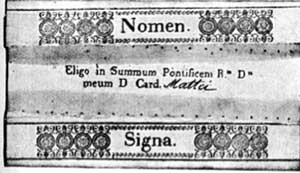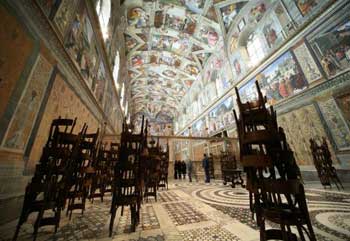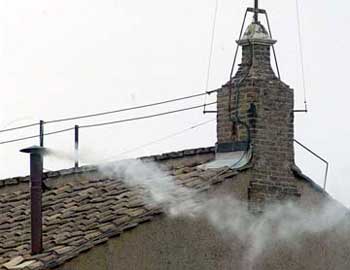The Pope election rules of the Roman Catholic Church regulate the Conclave to the smallest detail – including the nature of the ballot. Although black or white smoke are not mentioned.
“The ballots must be rectangular and must contain if possible in the upper half of the printed form the words: Eligo in Summum Pontificem, while the lower half must remain free to write the name of the selected here.” So it is written in section 65 of the Apostolic Constitution “Universi Dominici Gregis” of Pope John Paul II, the Pope’s election regulations currently in effect for the Conclave.
 Papal voting card
Papal voting card
But not only the nature of the ballot is regulated in detail. The Pope election rules dating back to 1996, which were changed in one point by Benedict XVI in 2007, contain some strict provisions, which go far beyond the election process itself.
The Dean of the College of Cardinals shall preside at the election, unless he is over 80 and thus no longer eligible to vote. In this case, he will be replaced by the Vice-Dean. If he is also over 80, the oldest of the highest ranking Cardinals takes over. This scenario will occur in the current conclave. Dean Angelo Sodano and Subdean Roger Etchegaray are over 80, so the 79-year-old retired Prefect of the Congregation of Bishops Giovanni Battista Re will take over the presidency of the conclave.
Room distribution by lot
During the conclave, the cardinals will reside in the premises of the Domus Sanctae Marthae, the guest house of the Vatican. The rooms are – mandatory by the electoral law – allocated by lottery. In addition to the Cardinals a few more people are involved, who need to swear under oath their ‘obligation to secrecy’. These include, among others, “two doctors for emergencies”, “some religious priests of different languages for confession” and “an appropriate number” of people “for service and cleaning.”
What happens behind the doors of the Sistine Chapel, is to stay there. The Electoral Code provides a number of steps to prevent eavesdropping.
 Sistine chapel
Sistine chapel
To prevent any information about the proceedings to get out of the Sistine Chapel, the electoral code foresees multiple mechanisms to foreclosure. Throughout the conclave, the cardinals are encouraged “to refrain from any correspondence by letter and telephone or any other way of communication”. Newspapers, magazines, radio and television broadcasts are strictly prohibited during the Conclave. The Internet is not specifically mentioned, but “the Cardinals may neither receive any messages of any kind nor send any outside the Vatican.”
Moreover, John Paul II goes into details several times in the Apostolic Constitution, regarding defense mechanisms against eavesdropping. “In a special way, careful and stringent checks must be made, with the help of trustworthy individuals of proven technical ability, in order to ensure that no audiovisual equipment has been secretly installed in these areas for recording and transmission to the outside.” it says in item 51.
New daily oath twice a day
The regulations for the actual election process begin only with chapter 62 of “Universi Dominici Gregis”. The process is accurately set. With the exception of the day on which the conclave begins, and where only one ballot is conducted, there are two ballots every other day mornings and afternoons. For every morning and afternoon. there will be apointed three election workers, three officers to collect the votes of sick Cardinals, and three Scrutineers, by lot. Additionally, every individuall eligible voter must swear the oath on each half-day.
The vote itself is planned down to the smallest detail. So the Cardinals may write the name “possibly in disguised, but clear writing” and then fold the paper exactly twice. One by one, they then cast their vote individually and having reached the altar, the Cardinal elector says aloud the words of the following oath: “I call as my witness Christ the Lord who will be my judge, that my vote is given to the one who before God I think should be elected.” He then places the ballot on the plate, with which he drops it into the receptacle. Having done this, he bows to the altar and returns to his place.
No smoke in the Electoral Code
After the votes were counted, the slips will be strung on a string – “. The last Scrutineer, as he reads out the individual ballots, pierces each one with a needle through the word Eligo and places it on a thread, so that the ballots can be more securely preserved.” If both ballots are completed in a half day, the list will be burned along with the records of all those present.
 Conclave smoke
Conclave smoke
Surprisingly, the electoral rules do not state how the combustion is to be performed. Because John Paul II. did not mention the black (or white) smoke, it was not clear whether there would be black smoke from the Sistine Chapel until the first round of voting in the conclave 2005, from which Pope Benedict XVI emerged.
However, it may take quite a while, before the redeeming smoke signal appears. After the first three days, the Electoral Code foresees a break of maximum a day in which, among other things a “spiritual address” by the most senior of the Cardinals in the order of Deacons, is on the agenda. After another seven unsuccessful ballots, there follows another break with “admonitory words” by the highest of the order of Priests and finally, after another seven, an “encouragement” by the senior Cardinal of the order of Bishops.
Agreements prohibited
Given the speculation about the successor to Pope Benedict XVI, especially in connection with the distribution of the College of Cardinals on the continents and on individual states, finally chapter 81 of John Paul II’s electoral code gets interesting: “The Cardinal electors shall further abstain from any form of pact, agreement, promise or other commitment of any kind which could oblige them to give or deny their vote to a person or persons. If this were in fact done, even under oath, I decree that such a commitment shall be null and void and that no one shall be bound to observe it; and I hereby impose the penalty of excommunication latae sententiae upon those who violate this prohibition. It is not my intention however to forbid, during the period in which the See is vacant, the exchange of views concerning the election.”
The Cardinal electors shall further abstain from any form of pact, agreement, promise or other commitment of any kind which could oblige them to give or deny their vote to a person or persons.
To really leave nothing to chance, the electoral rules not only regulates what the Cardinals have to do or not to do, but it also contains a clear statement to the congregation. During the Conclave, the entire Church “spiritually united with Mary, the Mother of Jesus, should persevere with one heart in prayer; thus the election of the new Pope will not be something unconnected with the People of God and concerning the College of electors alone, but will be in a certain sense an act of the whole Church.”

The statement to the congregation puts a great deal of responsibility on the faithful. So often, the laity feel they are but mere spectators in the election. We should be in constant prayer for the Holy Spirit to guide those involved.